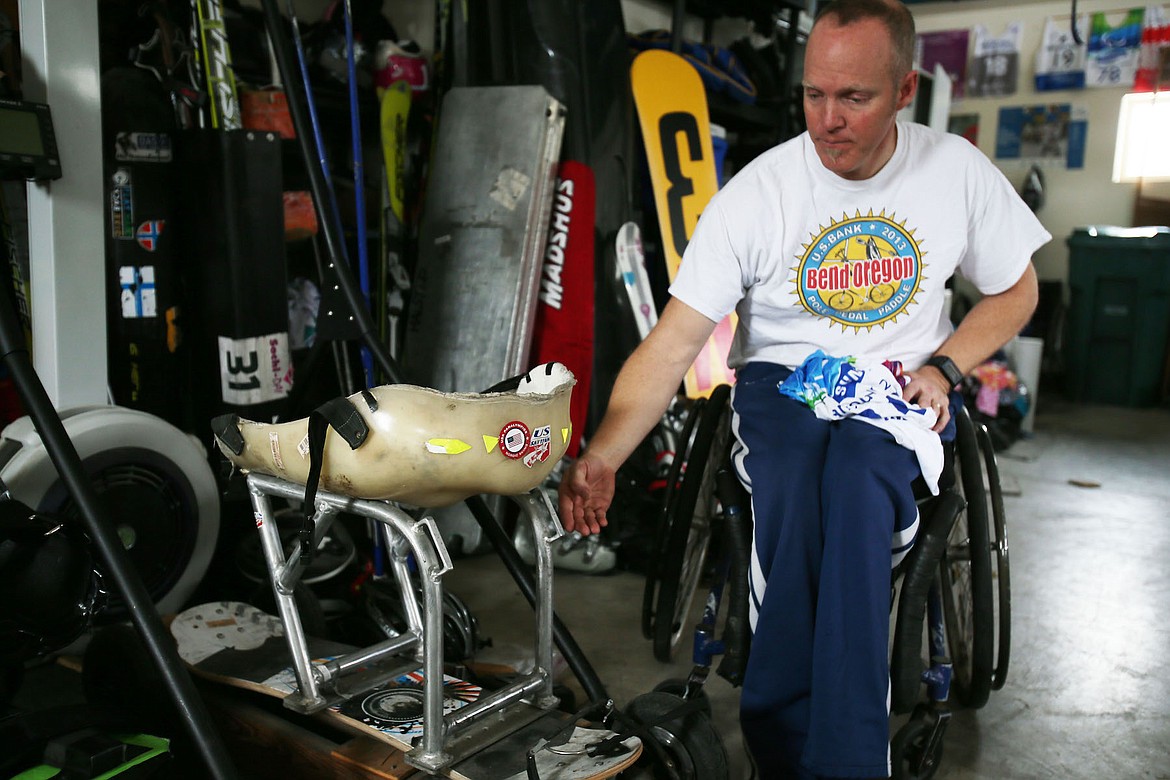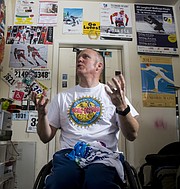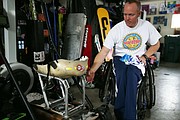Paralympian stands tall so others might follow
RATHDRUM — You can call Sean Halsted a lot of things — husband, dad, U.S. Air Force veteran, Paralympian — but don’t call him a perfectionist.
He didn’t earn a spot in three straight Paralympic Winter Games by stressing out. He’s gotten there by being the best version of himself he could be. His goal is to help other Americans do the same.
Halsted was born in Spokane courtesy of the U.S. Air Force, and grew up there because after 20 years in the service his dad retired to the Inland Northwest. He followed his dad’s footsteps into the wild blue yonder, but soon learned that his grades weren’t good enough to earn him a coveted pilot’s seat.
Undaunted, in 1993 Halsted went into the Air Force’s special operations force, called combat control. Halsted and his fellow combat controllers worked alongside their better-known peers, the Army Rangers and Navy SEALs, until one day in 1998 when he fell 40 feet during a training exercise. Halsted’s vertebra and career were shattered.
“Life made a huge right angle turn and drop when I got the spinal cord injury,” he said.
Unbeknownst to Halsted, veterans with even worse injuries than his were physically doing things he never dreamt were possible. Staff from the U.S. Department of Veterans Affairs used their stories to inspire him to get him out of his shell and into adapative sports.
The humble, determined overachiever was hooked.
“This concept of ‘you’re done’ was not true,” he said.
They had him try cross-country sit skiing and Halsted wondered, “Why would anyone want to do that?” After trying it and feeling the burn, Halsted realized “Oh! This is what I want.”
He tossed video games on the couch for punishing upper body workouts on the snow, ice, and in the gym. Halsted used his experience enduring tough physical challenges from high school cross country, Washington State University rowing, and the Air Force to become one of America’s top adaptive cross-country and biathlon athletes.
Despite competing at world-class levels, Halsted refuses to sacrifice his principles or family for athletic success. He fits in workouts on Mt. Spokane and weightlifting sessions at the Kroc Center around the times his three kids go to school and come home. He doesn’t nitpick over what he eats. He doesn’t have the time or energy for that, he said. He’s a dad who never knows if his teenagers will eat all the pizza, or only a slice of it.
Halsted doesn’t mind it, though. He’s just happy to be with them, and knows they’re growing up too fast. When Halsted leaves home for a competition, his concern is whether or not his wife, kids and house will function without the “dad taxi” there to run errands and simply be present.
As one of the older members of the U.S. Paralympic Team, Halsted also speaks up about the problems he notices in U.S. adaptive athletics.
For example, until this year’s Paralympics, Halsted said Paralympians made do with makeshift uniforms while representing the United States in international competition. The reason? Wildly disproportionate funding for the Olympians compared to the Paralympians.
This year Paralympians will finally get to wear the same sleek uniforms America’s Olympians wore weeks ago at PyeongChang. However, amputees and seated adaptive athletes don’t fit the uniforms the same way as able-bodied athletes, said Halsted, forcing the adaptive athletes to make do with uniforms that don’t quite fit their bodies.
His advocacy for adaptive athletes is for the guys who have even fewer advantages than he did when he was first injured. Halsted counts himself fortunate to have been a military veteran, because he was specially sought out when he was at his lowest.
“How are you supposed to know what to do when you’re a civilian?” he asked.
Even as a veteran, making his way from the couch to his first training clinic to really growing as an adaptive athlete was like going through a labyrinth. Adaptive athletes from Russia and Ukraine don’t have to figure out paperwork and bureaucracy, he said. In those countries, the government sends the national teams lists of potential adaptive athletes. Recruiters find the athletes, not the other way around like in America. In Russia, the athletes’ success and their nation’s reputation rise or fall in tandem. That translates into practical support for the adaptive athletes and extra motivation at international competitions, Halsted said.
Americans have to go it alone. That motivates Halsted to do what he can to inspire others to start the long journey into adaptive sports.
“My job as an American is to go out there and convince those guys that this is cool,” Halsted said. “He’s then got to see me, think it’s cool, see his therapist, and figure out how he’s going to get the cool carbon fiber frame like I’ve got.”
Halsted excels with his cross-country seated skiing frame and is grateful to have it, but it illustrates a real barrier to increased participation in adaptive sports. The frame Halsted will use while representing the United States at the world’s premier adaptive athletics event is held together with tape and took two years of volunteer labor to build. Some of his other training equipment looks like it came from a yard sale.
Thanks to his performance on the Nordic skiing national team, Halsted gets some financial help for travel expenses. Funds for the Nordic ski team have come in over the years via a nonprofit organization called Adaptive Spirit, as well as the U.S. Olympic Committee.
Halsted said the Paralympics are a great recruiting tool for future adaptive athletes because of all the media coverage there.
“How are you going to get someone excited unless people can see the competition throughout the events?” he said.
That’s one of Halsted’s overarching purposes for going to PyeongChang this month. In addition to getting to compete against dozens more athletes than usual, Halsted will go to the Paralympic Winter Games March 9-18 in the hopes that somebody who had given up hope will join him in the snow. All he’s after is more people to play with, he said.
It makes sense for a guy whose Air Force call sign was “Phantom.” Halsted enjoys pushing himself, but he loves being just one of the guys.







